Fresh from a fantastic weekend in London for Kennington Bioscope’s ‘SILENT LAUGHTER SATURDAY’, the blog is now ready to launch properly. Reviews of films from the weekend to follow, but before we get to that, here’s a brief rundown of some of the greatest forgotten comics you’ll find here. Sure, we’ll be featuring Keaton, Laurel & Hardy etc, too, but these are some of the comics who need a bit more information and appreciation about them on the internet, the core purpose of this site. As time goes on, I’d like to add pages for each of these performers to the site to hopefully become a definitive reference source, but for now, here’s a brief introduction to some of my favourite lost comedians…
- DAN LENO
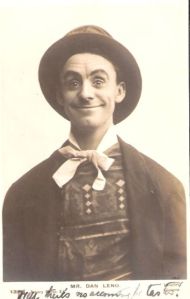
Going right back to the music hall days, it’s impossible to conceive of many of the later British comedians without Dan Leno. His sketches and whimsy were beloved by the Karno comics, and absorbed into their acts. Just look at that bowler-hatted, vacantly grinning face and tell me you don’t see Stan Laurel. Chaplin loved Leno, too. Leno died young at the turn of the century, and has left only scraps of his act, but he left a long shadow in British comedy.
2. MAX LINDER

Just as influential, in his own way, was Frenchman Max Linder. Stage-trained Linder made films from the mid-1900s for Pathé. These films may look primitive, with their cardboard, painted sets, but Linder’s acting is remarkably subtle and sophisticated. As a silk-hatted boulevardier, he maintains this pleasingly low-key style as he is pulled into ridiculously farcical situations, such as being carried through the streets of Paris in his bath!
Chaplin, again, was a huge fan. He became friends with Linder (below), dedicating a photo to him, “To the one and only Max, the Professor. From his disciple, Charles Chaplin.” Linder’s sophisticated, dapper style in the face of eternal embarrassment was also a huge influence on two other great silent comics, Raymond Griffith and Charley Chase.
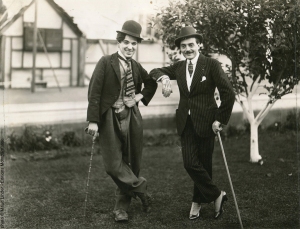
3. ROSCOE ARBUCKLE

It’s amazing how many of these underappreciated comedians had such an influence on the more enduring names. It was Roscoe ‘Fatty’ Arbuckle, then Mack Sennett’s biggest star, who persuaded the producer not to fire a young, temperamental Chaplin. He’s also said to have provided the original tramp costume’s oversized pants. The eternally generous Arbuckle later had an even more profound impact on the young Buster Keaton,giving him his first screen roles and teaching him the ropes of film-making. On his own account, he made some really charming and funny screen comedies, before his career was unduly and unfairly stopped by a 1921 scandal. To this day, it’s impossible to write a paragraph about him without mentioning it, so I’m just going to shout from the rooftops, “HE WAS INNOCENT!” once more.
4. MABEL NORMAND

The first really popular screen comedienne, Mabel was also a pioneering female director. From the mid 1910s, she was directing her own films at Keystone, later moving into feature films for Goldwyn. She’s great proof that women could be both funny and attractive at the same time, which was a difficult thing to achieve in such a male-dominated industry. Mabel was a wonderfully lively performer, who deserves remembering more for her pioneering work.
5. ALICE HOWELL

Alice Howell took a more clownish approach to her humour. Her round, eternally started kewpie doll face, topped off with a mass of frizzy red hair was instantly amusing, and totally suited the ditzy characters she played on film. However, she was still a true original, almost a forerunner of Lucille Ball. Her films are sadly scarce, but reveal a uniquely funny lady. “Everyone a Howell!” was her strapline.
6. LUPINO LANE

To see one of Lupino Lane’s films is to suspend belief in the laws of physics; he was a phenomenal acrobat who surpasses even Keaton. Tracing his family’s history in entertainment back to 1642, he was a proud inheritor of the pantomime tradition, and could do pretty much anything: acrobatics, dancing, singing, crosstalk routines, juggling. He later added starring in, writing and directing Hollywood comedies to his resumé. These films are great little two reelers, maybe not deep in characterisation, but they make up for it in a whirlwind of gags and acrobatics. Lane’s signature stunts include rising up from the splits, somersaulting down flights of stairs, and running 360 degrees around the inside of a proscenium arch! In later years, he returned to England, where he originated the role of Bill Snibson in ‘ME AND MY GIRL’, along with the famous dance, ‘The Lambeth Walk’. He should be recognised as a national treasure in Britain, but is undeservedly forgotten.
7. CHARLEY BOWERS
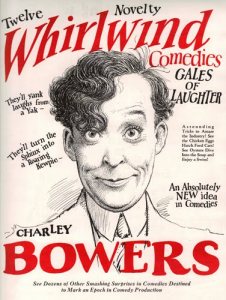
The films of Charley Bowers are as jaw-dropping as Lupino Lane’s, but for different reasons. Bowers isn’t an astounding performer, but he was an incredibly talented animator and gagman. In two series of comedies in the late 1920s, he mixed his wild, incredibly realistic stop motion animation into live action films starring himself. The results are incredible, a world where pussy willow trees sprout living cats, mice fire guns, cars hatch from eggs and the figures inside paintings come to life. Beloved by surrealists like André Breton, Bowers was just way ahead of his time, and returned to obscurity before being rediscovered in recent years.
8. HARRY LANGDON

Langdon is usually cited as one of the “big 4” names of silent comedy, with Chaplin, Keaton and Lloyd, but he’s far, far less well remembered than those performers. Part of the reaon, I think, is that he is very much an offbeat, reactionary performer, a minimalist in reaction to the overblown chaos of Mack Sennett madness. Now that we’re less familiar with this, it’s harder to place Langdon’s curious, quiet style. He played an overgrown baby of indeterminate age, his performances marked by long silences and the tiniest flinches in facial expression. He was proclaimed as the next Chaplin in his day, but crashed and burned through a combination of factors. He’s kind of a marmite performer, an acid test for your appreciation of silent comedy. Those who ‘get’ him revere him. Among them were Chaplin, Keaton and Stan Laurel. That must count for something.
9. LLOYD HAMILTON
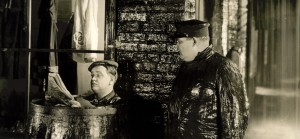
You might recognise the photo above from our header image. Lloyd Hamilton (on the left) is another comedian’s comedian, a reactionary type who has a similarly ‘marmite’ appeal to Harry Langdon. Playing a curious overgrown Mama’s Boy type, he walked with a prissy waddle and treated everything with disdain. A typical Hamilton film has little story, but is simply a string of disasters to showcase his fine reactionary comedy. However, he’s hamstrung (pardon the pun) by the lack of most of his best films, and the fractured and scattered nature of what remains. But, as Mack Sennett said, “[Lloyd Hamilton] had comic motion. He’d do nothing but walk across the screen and make you laugh.”
10. CHARLEY CHASE

I simply adore Charley Chase. Debonair, charming and a multi-talented gagman, director and story-constructionist, he had a knack for creating beautiful little farce comedies that escalate to heights of absurdity yet remain completely believable throughout. For example, ‘MIGHTY LIKE A MOOSE’, in which he and his wife have plastic surgery without telling each other, meet on the street, and then embark on an affair. It’s a totally ridiculous story, yet made believable and human by the warmth and skill of Chase and his team. Chase continued doing some great, charming work in the talkies, making short films at Hal Roach studios that need to be seen more widely.
11. WALTER FORDE

Walter Forde was once billed as ‘Britain’s only comedian!”. That’s rather stretching it, but he was the only comedian making film comedy shorts and features in Britain for most of the silent era. Forde’s work in this area continues to be undervalued, but is slowly being re-evaluated. He played a likeable chap, “two parts Chaplin, three parts Harold Lloyd,” as one reviewer put it, and directed his films himself. A shy man, he gave up performing in 1930, and instead became a renowned director of both comedies and dramas.
12. WILL HAY

Taking Walter Forde’s place as premier comic of British films in the sound era was Will Hay. Hay’s music hall character was an incompetent ignorant schoolmaster who was barely a step ahead of his pupils. This enabled him to follow a rich line of comedy, transferable in films to any position of seedy authority: ship’s captain, shyster lawyer, policeman, or stationmaster in his all-time classic ‘OH, MR PORTER!’. Hay’s films are acknowledged as classics, but as a performer he needs some more love. he’s another superb reactionary comedian, a master of pauses, sniffs and shady glances to sell material that looks feeble on paper. He’s also one who stands up very well today, as British bureaucracy and incompetence hasn’t gone anywhere in the 65 years since his passing…
13 CLARK & McCULLOUGH
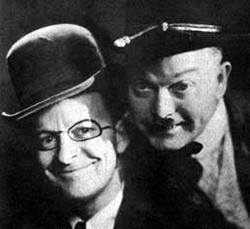
We close with a wonderfully vibrant act who flourished in sound comedies. Clark and McCullough were successful on Broadway before making a great little series of sound two-reel shorts for RKO in the early 1930s. They are often considered Marx Brothers rip-offs (partly due to Bobby Clark’s painted-on glasses), yet turned out a brand of humour uniquely their own, rich in movement, dialogue, pantomime and farce.
As I leave off here for now, I’m already thinking of the other comics I haven’t included here today… Raymond Griffith, Jack Hulbert, Stanley Lupino, Snub Pollard, Thelma Todd… Rest assured, they’ll all have their place here. I hope you’ll bookmark this site and keep dropping by from time to time to share these great performers with me. Next up, some highlights from ‘SILENT LAUGHTER SATURDAY’, featuring some of the names above.
















